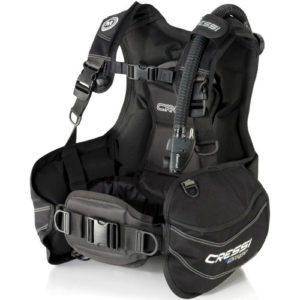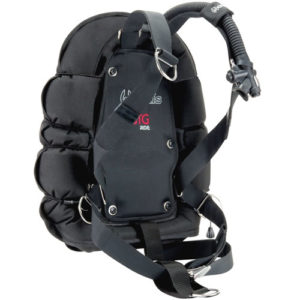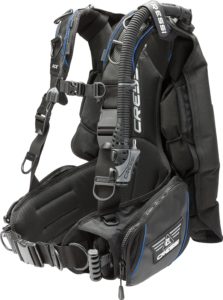As a casual recreational diver, chances are you’re using a jacket-style BCD. At some point, though, you’ll likely see divers wearing wing-style BCDs. What’s the difference, and is one better than the other? Here’s a rundown of both so you can make an informed selection when it comes to choosing a BCD.
Jacket-style BCDs
 By far the most common type of BCD, the jacket-style comes in all shapes and sizes. These are also gender-specific for a better fit. On a standard jacket-style BCD, the shape of the bladder inside means that air migrates around the waist and up to the chest, with little or no air on your back. This allows you to stay comfortably vertical when on the surface, or lie on your back easily if surface swimming short distances.
By far the most common type of BCD, the jacket-style comes in all shapes and sizes. These are also gender-specific for a better fit. On a standard jacket-style BCD, the shape of the bladder inside means that air migrates around the waist and up to the chest, with little or no air on your back. This allows you to stay comfortably vertical when on the surface, or lie on your back easily if surface swimming short distances.
However, when underwater, the movement of air inside the unit can make it more difficult to achieve an even horizontal, or prone, position. Consequently, even when neutrally buoyant, many divers are a little “leg down.” This is not as streamlined as the prone position (think of how a skydiver lies). Getting the wrong fit can also make buoyancy control more difficult, especially if you’ve got a BCD that is too big for you. The air can move around more, which can make the unit feel unstable.
Generally, jacket BCDs tend to have large pockets, which come in handy for carrying all kinds of things like torches and pocket masks. These can be somewhat difficult to access when you’re fully inflated on the surface. Integrated weights are now common to most jacket BCs. These are a great alternative to wearing a weight belt or weight harness when drysuit diving, and make it easy to drop weights in an emergency.
Many divers also like how easily jacket BCs attach to the cylinder, and how effortless they are to don and doff. However, they are bulky and take up a lot of space when traveling, which is a big consideration when going on a scuba vacation. There are lots of lighter, travel BCs on the market, however. Overall, jacket BCs are still by far the most popular choice among divers.
Wing-style BCDs
 This type of BCD originates from technical diving, where divers are using a twinset of two tanks or a rebreather. In recent years, wing-style BCs have appeared in single-tank diving. The principle is very simple: the diver wears a harness that is attached to an aluminum or steel back-plate. The inflatable wing is attached to the back-plate and sits on the diver’s back between the diver and the cylinder. Wings are available in doughnut and horseshoe shapes, but the most common is the doughnut. On this one, a continuous bladder allows air to migrate around the entire outer part of the wing.
This type of BCD originates from technical diving, where divers are using a twinset of two tanks or a rebreather. In recent years, wing-style BCs have appeared in single-tank diving. The principle is very simple: the diver wears a harness that is attached to an aluminum or steel back-plate. The inflatable wing is attached to the back-plate and sits on the diver’s back between the diver and the cylinder. Wings are available in doughnut and horseshoe shapes, but the most common is the doughnut. On this one, a continuous bladder allows air to migrate around the entire outer part of the wing.
Wing-style BCs have a few benefits. You can easily swap the BC for a larger one if you’re doing a technical dive requiring greater lift, i.e. a twinset. In this way, you have the same harness system for each type of diving. Since the wing sits on your back, it’s easier to achieve that horizontal prone position underwater. This is very streamlined and makes you less of an entanglement hazard. With a wing-style unit, there is nothing around your waist apart from the harness, so you feel less encumbered. Just as with jacket-style BCDs, most wing-style units feature weight pockets. These can still be quick-release, and you can also add additional pockets. If you want to minimize your lead, a thicker steel back-plate is a sensible choice. If you go on scuba vacations, then a thinner, aluminum back-plate would be more suitable.
One disadvantage of a wing-style BCD is that it can be more difficult to stay vertical on the surface. Since the air is on your back, there is a tendency to go face down. However, you can easily remedy this with experience by lifting the knees up slightly and lifting your head back. Technical divers swear by this set up, and among the wider diving community, wing-style BCs are becoming more popular because they are so adaptable.
Back-inflate jacket-style BCDs
 This hybrid style is a combination of both the above styles, designed to take advantage of the best of each in one system. There are quite a few different models available, each with its own characteristics. The lightweight new Cressi ACE, for example, features a detachable harness and air cell.
This hybrid style is a combination of both the above styles, designed to take advantage of the best of each in one system. There are quite a few different models available, each with its own characteristics. The lightweight new Cressi ACE, for example, features a detachable harness and air cell.
Back-inflate models all strive to fit like a jacket around your waist and shoulders and also provide lift from a bladder on your back. This makes it easy to attain that horizontal position without a separate wing and back-pate. They still have large pockets at the waist, but as with jacket BCs, it can be a little more difficult to feel steady in a vertical position when at the surface.
When it comes to dive equipment, it’s hard to “try before you buy” unless you have generous, similarly sized friends. Often you must do your research before choosing a BCD and hope you made the right decision once you’ve purchased your equipment. Buying a BC is no different, but armed with the above information, the choice might be a little bit easier.

